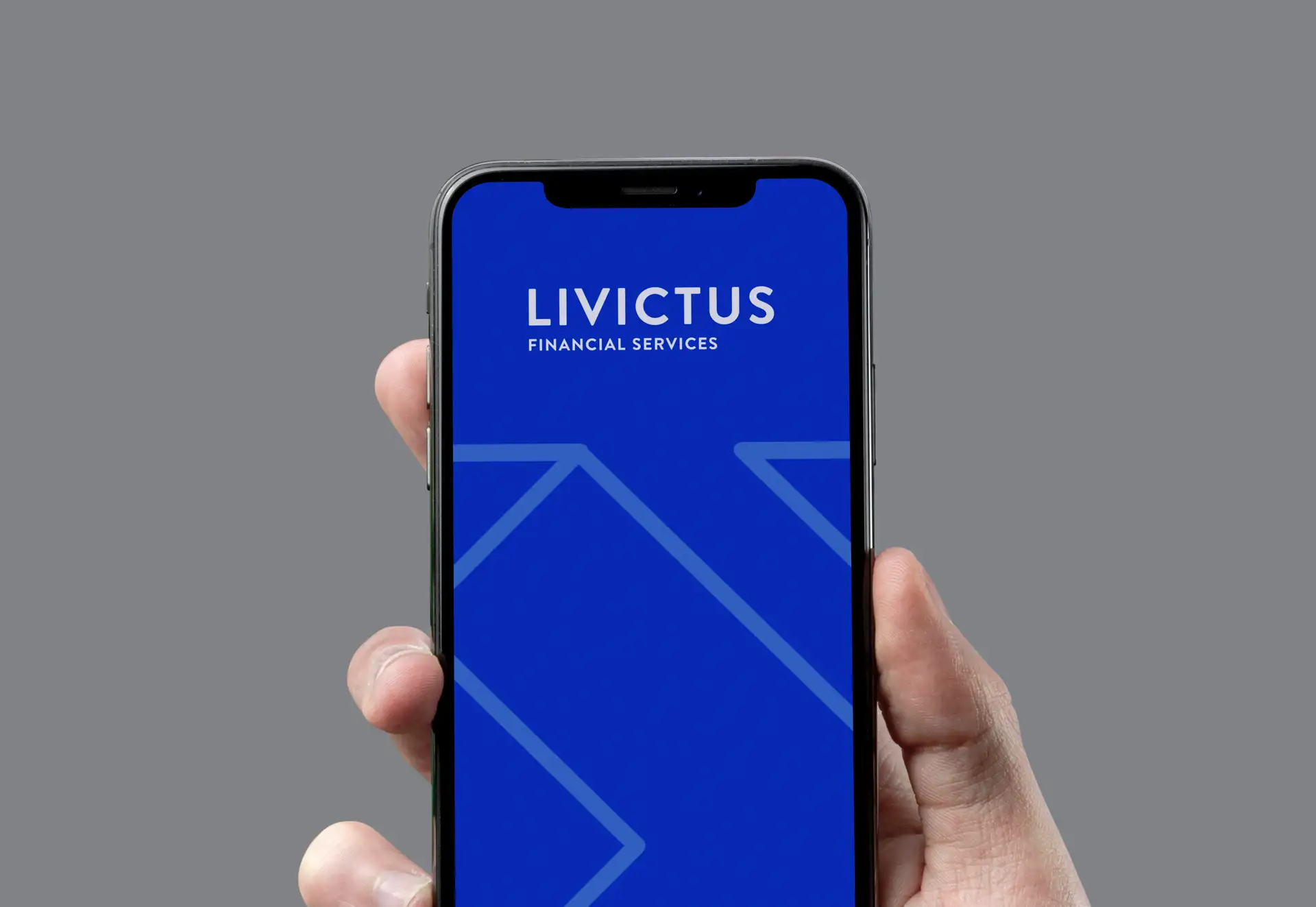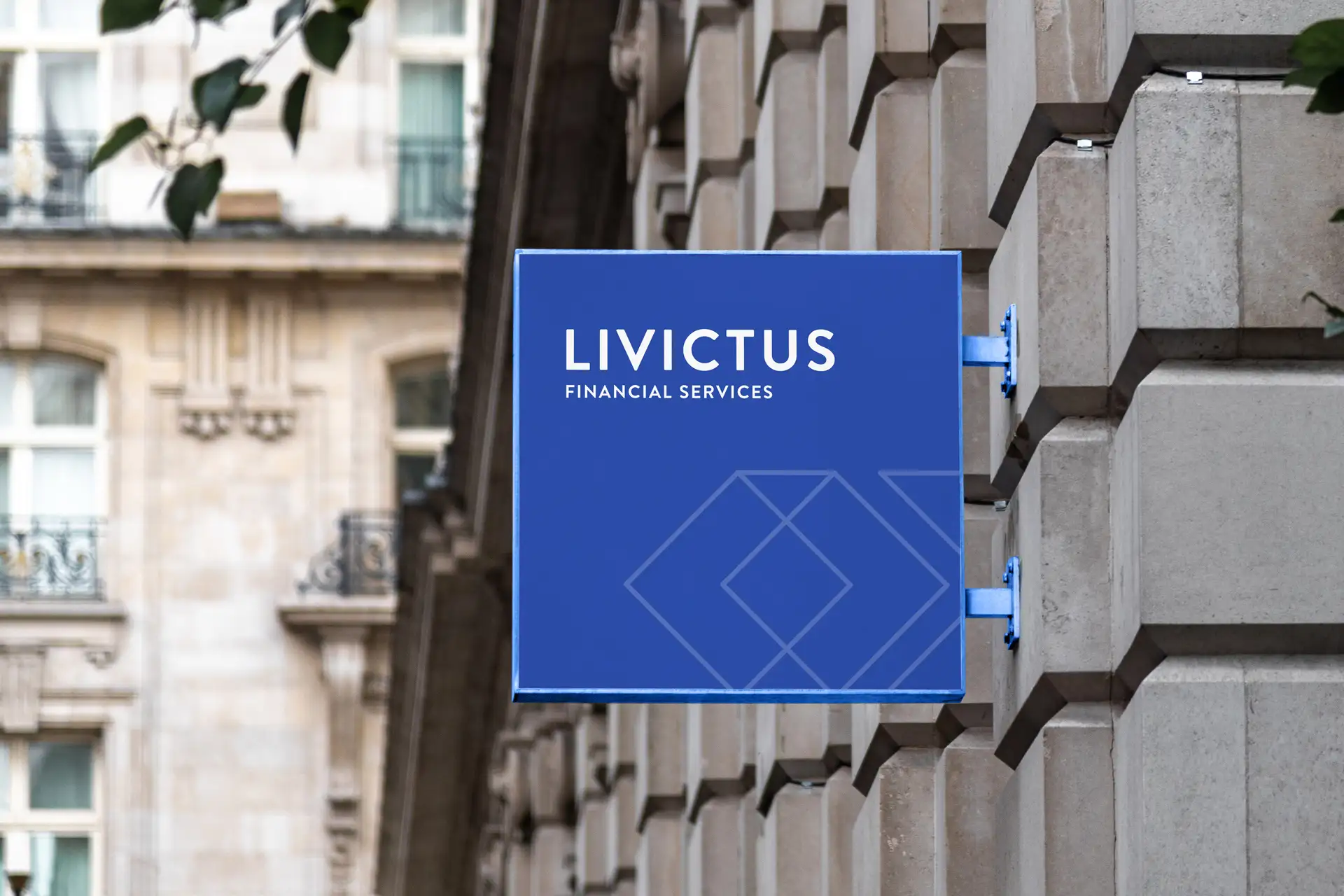Livictus: Living with Victory Through Financial Wellness
Situation: Creating Brand Identity for Comprehensive Financial Planning Company
Comprehensive Financial Planning (such as Retirement Planning, Estate Planning, College Savings – establishing the appropriate financial strategies to achieve goals) company came to Spellbrand for a brand strategy, a new name and a visual language.
The financial services market requires brands that communicate trust, expertise, and personalized service. The company needed a brand identity that would differentiate them while communicating their comprehensive approach to financial planning.

Task: Create Brand Strategy, Name, and Visual Language
The challenge required:
- Brand strategy: Complete brand strategy development after exhaustive process
- Brand naming: New brand name creation based on Greek lexicon
- Visual language: Visual language development communicating brand identity
- Financial planning: Brand that communicates retirement, estate planning, college savings services


Action: Strategic Brand Development
Brand Strategy & Name: Living with Victory
We created a brand and positioning strategy for this client after an exhaustive process of discovering their core essence, creating their audience personas and archetypes, their differentiation, their brand story and a complete messaging framework.
Then we came up with a stunning new brand name – Livictus – based on Greek lexicon and is all about living with victory and tied to financial wellness.
Result: Brand Identity That Lives with Victory
The brand identity we created for Livictus successfully communicates comprehensive financial planning. The comprehensive brand transformation delivers:
Strategic Outcomes
- Brand strategy: Brand strategy successfully developed after exhaustive process
- Brand naming: Brand name successfully created based on Greek lexicon
- Visual language: Visual language successfully developed communicating brand identity
- Financial planning: Brand successfully communicates retirement, estate planning, college savings services
- Complete brand system: Brand name Livictus, brand strategy, visual language, and messaging framework create unified experience
Implementation Success
Today, Livictus uses this comprehensive brand identity to attract clients who need comprehensive financial planning services. The brand name Livictus, based on Greek lexicon and all about living with victory and tied to financial wellness, successfully communicates the brand’s core essence discovered through exhaustive process of creating audience personas and archetypes, differentiation, brand story and complete messaging framework. The brand successfully positions Livictus as a comprehensive financial planning company that establishes appropriate financial strategies to achieve goals in retirement planning, estate planning, and college savings, with visual language that consistently and coherently communicates the brand’s identity.




Frequently Asked Questions
What role does a brand strategy play in attracting potential clients in the financial sector?
Brand strategy is critical for businesses in any sector, including financial services, and plays a key role in attracting potential clients. This strategy is the roadmap for how a brand presents itself to the world and, more importantly, its target audience.
It encompasses the brand’s mission, values, promise, personality, positioning, and visual elements – all designed to create a coherent and distinct identity in the market.
In the financial sector, where trust and credibility are paramount, a well-thought-out brand strategy can be instrumental in appealing to potential clients. Here’s why:
Differentiation: The financial sector is saturated with numerous firms offering similar services. A robust brand strategy helps distinguish a company from its competitors, showcasing its unique value proposition and the specific benefits it offers.
Trust and Credibility: The financial industry revolves around sensitive matters such as personal wealth and planning for the future. Potential clients look for firms they can trust with their hard-earned money. A consistent and professional brand strategy can enhance perceived reliability and authenticity.
Emotional Connection: A strong brand strategy goes beyond simply displaying services; it tells a story and communicates the brand’s values and purpose. This can resonate with potential clients emotionally, creating a connection that could influence their decision to choose one firm over another.
Visibility: An effective brand strategy ensures that the brand message is clear, compelling, and visible across all touchpoints – from digital advertising and social media to traditional print materials. This increased visibility can attract potential clients seeking the financial services you offer.
Customer Loyalty: A strong brand strategy fosters customer loyalty once potential clients are converted to actual clients. Consistent brand message and visual identity create a memorable experience that clients will want to return to and recommend to others.
Financial service providers can attract and retain their ideal clients by understanding and leveraging these aspects of a brand strategy.
How does creating a new name work, and how can it influence the perception of our financial services?
Creating a new brand name, often called “naming” or “brand naming,” is a critical aspect of brand strategy and involves several key steps. The objective is to create a name that captures the essence of the brand, connects with the target audience, and differentiates the company in the market. Here’s an overview of the typical process:
Brand Analysis: This step involves deeply understanding the brand – its vision, mission, core values, unique selling proposition, and products or services. Understanding the brand’s target audience, their preferences, and what resonates with them is crucial.
Competitive Research: Reviewing the industry’s landscape, including competitors’ names, can provide insights into naming conventions and trends within the sector. The goal here is to identify opportunities to stand out.
Brainstorming and Ideation: Armed with an understanding of the brand and its competitive environment, the creative process begins. This step typically involves generating a long list of potential names, often with the input of various team members or stakeholders.
Evaluation and Shortlisting: The generated names are evaluated based on several criteria, such as their relevance to the brand, ease of pronunciation and spelling, memorability, and availability (including domain names and trademarks). This process helps to refine and shortlist the potential options.
Testing: The shortlisted names can then be tested with a target audience sample or through focus groups. Feedback can provide valuable insights into the perceptions and potential interpretations of the names.
Final Selection and Registration: Once the name has been finalized, it’s necessary to ensure its availability from a legal perspective, including domain registration and trademarking, to secure exclusive usage rights.
The new name of a company can significantly influence the perception of its financial services. A carefully chosen name can encapsulate the brand’s essence and position it as reliable, trustworthy, and professional in the mind of potential clients.
The name can also convey the unique attributes of the company’s services, fostering a connection with the target audience and creating a differentiated identity in the competitive financial services sector.
Ultimately, a strong brand name can be a driving force in conveying the brand’s story, values, and mission to its customers, thereby influencing their perception and decision-making process.
What factors are considered when developing a visual language accurately representing our comprehensive financial planning services?
Developing a visual language for a brand is a crucial part of the branding process. It involves creating a set of design elements and guidelines that consistently and coherently communicate the brand’s identity.
In the case of comprehensive financial planning services, the aim is to convey qualities such as trust, professionalism, expertise, and personalized service. Here are the factors considered when developing an effective visual language:
Brand Values and Personality: The visual language must align with and express the brand’s values and personality. If a brand prides itself on transparency, this could be conveyed through clear, clean lines and open space in design elements.
Target Audience: The visual language must resonate with the target audience. The demographic characteristics, preferences, and needs of your audience can influence the choice of colors, typography, imagery, and other visual elements.
Industry Standards and Expectations: Financial services are associated with qualities such as trust, stability, and security. Therefore, the visual language typically includes more conservative color palettes (blues, grays, greens), formal typography, and professional imagery.
Differentiation: The visual language should help set your brand apart from competitors. This can be achieved through unique design elements or a distinctive application of color, shape, and composition.
Consistency: Consistency across all touchpoints strengthens brand recognition. This requires a well-defined set of guidelines for the use of logos, colors, typography, imagery, iconography, and other graphic elements.
Communication Clarity: The visual language must facilitate clear and effective communication. This can involve the use of infographics or other visual aids to explain complex financial concepts in a more accessible way.
Adaptability and Scalability: The visual language should be versatile enough to be used across various platforms (website, social media, print materials) and scalable to different sizes without losing its impact or clarity.
Emotional Resonance: Though often overlooked in financial services, the visual language can and should evoke positive emotions and connect with clients on a personal level. This could mean using imagery that resonates with clients’ aspirations, such as achieving financial freedom or securing their family’s future.
Creating a visual language that accurately represents your financial planning services is a strategic process that, when executed effectively, can significantly enhance your brand’s perception and resonance with your target audience.
How can a well-designed logo contribute to the trust and credibility necessary in the financial industry?
A well-designed logo design plays a significant role in establishing trust and credibility in the financial industry for several reasons:
Professionalism: A well-crafted logo conveys professionalism, indicating that the company pays attention to detail and values quality. This can generate a positive first impression, fostering trust among potential clients.
Identity: A logo acts as the face of a company, being a visual representation of its identity. When designed thoughtfully to reflect the company’s values and services, it can contribute to the overall credibility of a financial firm.
Consistency: A logo reinforces brand recognition when used consistently across all channels and touchpoints. The repetition and familiarity breed customer trust, which is crucial in the financial industry.
Differentiation: A unique logo helps set a company apart from competitors. By standing out in a crowded market, a company can position itself as a credible and distinct choice for financial services.
Memorability: A well-designed logo is memorable, keeping the brand at the top of client’s minds when they require financial services. This ongoing mind presence reinforces trust and credibility over time.
In essence, a well-designed logo can be a key factor in establishing and maintaining the trust and credibility crucial for success in the financial industry.
Can you explain how the branding process is adapted for specific areas of financial services, such as retirement planning, estate planning, and college savings?
Certainly, branding in the financial industry requires a nuanced approach as different service areas have specific needs, target demographics, and strategic considerations. Here’s how the branding process can be adapted for areas like retirement planning, estate planning, and college savings:
Retirement Planning: Given that the target audience for this service is often older adults, branding should communicate reliability, expertise, and long-term commitment. A mature, professional color palette, straightforward language, and visuals depicting successful retirement lifestyles can be effective.
Estate Planning: This service deals with sensitive topics like wealth preservation and transfer after death, which requires high trust. Branding may focus on communicating empathy, confidentiality, and peace of mind. The use of conservative yet sophisticated design elements can help convey these messages.
College Savings: Typically aimed at younger families, branding for college savings plans might emphasize growth, future planning, and the value of education. A more vibrant and optimistic color palette and images of academic achievement and success can resonate with this audience.
In each case, understanding the audience’s unique characteristics, needs, and aspirations allows the branding process to be tailored effectively. The goal is to create a brand identity that speaks directly to the target demographic, accurately reflecting the nature of the service and setting the right expectations.





